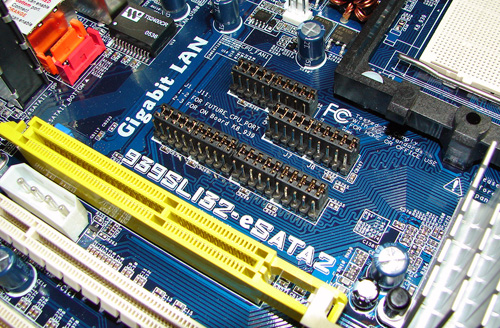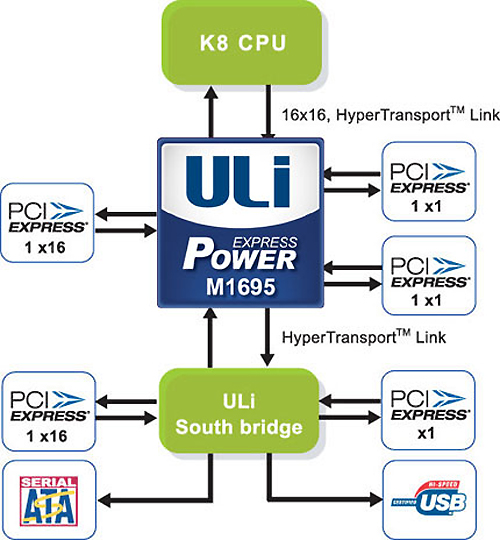ASRock 939SLI32-eSATA2: ULi Dual x16 SLI
by Gary Key on March 2, 2006 12:15 PM EST- Posted in
- Motherboards
"The more alternatives, the more difficult the choice."
This quote by Abbe' D'Allanival conveys our feelings about the ASRock 939SLI32-eSATA2 product. ASRock began operations in 2002 as the value brand group for Asus. ASRock has a history of providing very unique and, at times, unusual products based upon alternative chipsets at inexpensive price points. Although ASRock offers a complete line of products based upon mainstream chipsets from Intel and NVIDIA, it is their products based upon ULi, SIS, and VIA chipsets that are usually far more interesting. More information about the entire line of ASRock products can be found here.The ASRock 939SLI32-eSATA2 motherboard is based on the ULi M1697 and M1695 chipsets. ASRock has done a masterful job in utilizing these recently released chipsets to create a board that might make you think twice about spending any additional money for an NVIDIA nForce4 dual X16 SLI solution. In fact, this board fully supports NVIDIA SLI technology and it works seamlessly with the included ULi PowerExpress Engine Enabling driver although the board is not SLI certified by NVIDIA. Of course, now that NVIDIA has completed their acquisition of ULi, we have to wonder how many manufacturers will be able to provide a similar solution utilizing these chipsets or how long this driver will be available.

During our testing and general usage of the ASRock 939SLI32-eSATA2, we found the board's stability to be exceptional and it delivered competitive results in the latest synthetic and game benchmarks. However, our initial impressions were not as positive at the beginning of the test phase as the board would sporadically produce random results in the synthetic benchmarks while generating lockups in the memory benchmarks. Our issue was with the pre-release test BIOS and was not visible in the production release BIOS on the shipping boards. While the performance of the board was slightly lower in most benchmarks, the stability was superb with the release BIOS.

ASRock utilizes the ULi M1695 HyperTransport PCI Express Tunnel chip for the North Bridge. The ULi M1695 is designed to interconnect seamlessly with other HyperTransport based Host or Bridge chips and, in this case, is interconnected to the ULi M1697 acting as the South Bridge. The M1695 fully supports one PCI Express x16 lane or two x8 lanes for graphics cards and two PCI Express x1 or one PCI Express x4 expansion slot. The M1695 offers transfers of up to 16-bit HTT downstream and 16-bit HTT upstream links at 2.0 GT/s, ensuring an excellent communication path between the processor and connecting bridges.

The ASRock 939SLI32-eSATA2 offers the full complement of options available including two PCI Express x16 connections (fully supports NVIDIA SLI with PowerExpress driver); one PCI Express x4 connection, three 32-bit PCI 2.2 connections, and a unique CPU upgrade port that fully supports the AM2 940-pin CPU with an AM2CPU daughter board. The board also offers HD audio via the Realtek ALC660 HD 5.1 codec, PCI Express Gigabit Ethernet via the Realtek RT8111B PHY, eight USB 2.0 ports (utilizing two USB 2.0 headers), four SATA 3Gb/s connectors, two eSATA 3Gb/s connectors (shared with two SATA 3Gb/s ports), two ATA133 Ultra-DMA IDE connectors, and IEEE 1394 support via the TI TSB43AB22 1394A capable chipset.
Let's find out if this alternative offering leads to a difficult choice.










46 Comments
View All Comments
UJMA - Sunday, March 5, 2006 - link
I see, I'm still interested to see how this Epox board overclocks, I look forward to the Anantech review. If its priced similar to the Asrock Sli but with better voltage options I will get one despite it being x8 x8 ... thanks for the info.UJMA - Saturday, March 4, 2006 - link
fantastic!!! I rate Epox boards highly, I'm waiting for that particular board to make an appearance in the UK ... I look forward to your results!Redrider - Saturday, March 4, 2006 - link
I am looking to build a system for my 15 year old son who does video editing as his system stressing function, not gaming. We do video editing on my own aging but still quite nice FIC AU13max, Athlon2500+, All-in-Wonder 9700pro, 1GB (2x 512)PC2700, system that I built 3 years ago (my only other previous build). I want to build a system that will be good for video editing primarily but provide for gaming should his gaming interest change from his Playstation2 to his PC. I would build my own system and pass my old system down to him like I did last time, but really like the DVR/home theater I have set up with my TV, JVC 9010VBK receiver, and AIW AGP card.Anyway, things sure have changed since my last build! I could use a bit of guidance. I am considering this board and would like advice on the least expensive (as a baseline, I will work my way up from there budgetarily) CPU, memory, video card, etcetera that would serve the aforementioned needs.
To add a bit of complexity to my question (I hope this off topic diversion is ok) I had been considering a DFI LP UT NF4 Ultra-D mainly for the future potential if he gets into overclocking and such as well as the cool factor with a uv lighted case. Some reviews gave this poor marks for stability at the default settings which sent me looking elsewhere like here. Does the X2 support of the ASRock 939SLI32 warrant going with a dual core and this board for multitasking capability?
Thanks for your assistance.
dab - Saturday, March 4, 2006 - link
my $.02I just RMA'd a defective Ultra-D. The power requirements are very high, as it is capable of severely overvolting your hardware. It is also a very advanced board and may be difficult to use in many situations. Read at dfi-street.com before purchasing system components if you're serious about this avenue.
Perhaps he would be better off with a less demanding, more user friendly board like the Asrock board or an Asus offering.
Redrider - Saturday, March 4, 2006 - link
Thanks for the heads up. I was a bit apprehensive about the reviews referencing compatibility issues on the DFI. This ASRock seems interesting. Asus seems like people either love'm or hate'm. I tend away from mainstream as evidenced by my FIC Mobo which appears to be one of the last of the line. I guess I'll keep on looking to see what I come up with.If I go with the ASRock any component suggestions? Any other specific components that I should avoid?
Live - Friday, March 3, 2006 - link
Great to see the new way of presenting the gaming benchmarks. The "min" numbers are especially useful. Nice and easy to understand as well. Keep up the good work! I hope you will continue to use this in all your gaming benches. With the reports/speculation of Nvidias next high end offering being close to ATIs X1900XTX in the sense that it will beat it in some and loose in others this extra info might be the decisive factor.Missing Ghost - Thursday, March 2, 2006 - link
I don't like it. The layout is not very good. The chipset heatsinks look crappy. It seems like the southbridge heatsink is too high and will be in the way of expansion cards. And why a 20 pin power connector? I want 24 pins, especially because this board supports sli. I think I can find better for this price, but maybe that's because I don't care about 16x pcie slots.kelim - Thursday, March 2, 2006 - link
Can anyone confirm what (if any) Zalman HSFs are compatible with this motherboard?Gary Key - Friday, March 3, 2006 - link
Zalman CNPS-9500 - YesZalman CNPS-7700 - No
Zalman CNPS-7000 - I do not have this item but looking at the measurements it would be extremely close, taking the measurements off the 7700 unit in place it might fit but just as easily might not.
kelim - Saturday, March 4, 2006 - link
Thank you good sir. The 9500 is what I'll be coupling with this baby.